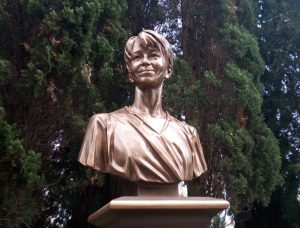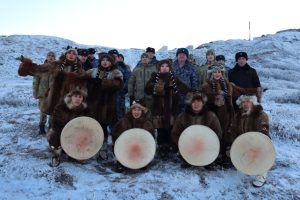Virgin Galactic flights soar to edge of space; Singapore spaceport mooted – !
NEW MEXICO – Would you pay US$600,000 (S$810,000) to ride on a spaceship and experience three minutes of weightlessness?
For about 700 people – two of them based in Singapore – the answer to that question is a resounding “yes”, and each has put down a hefty deposit for a spot on the “future astronaut” waiting list at Virgin Galactic, British billionaire Richard Branson’s space tourism company.
The flight to and from space lasts about two hours, just three to five minutes of which is spent floating almost 90km above the surface of the Earth.
The Virgin Galactic carrier aircraft, or “mothership”, takes off with the smaller spaceship tucked beneath it and ascends to an altitude of about 15km. The spaceship is then released, igniting its rocket motor and accelerating to three times the speed of sound until it reaches the edge of space.
When the craft reaches its maximum altitude of about 88km, passengers unclasp from their seats and experience microgravity – and an unparalleled view of the Earth – before the ship glides back to the ground.
While the experience itself is fleeting, the company spends months preparing customers for what is often the fulfilment of a childhood dream.
They are also initiated into a hyper-exclusive community of future and former astronauts, who are all invited to holiday on Necker Island, Mr Branson’s private Caribbean getaway.
So far, only 23 people have flown as paying customers on the seven commercial flights Virgin Galactic has operated since 2023, but the company is scaling up, building a new class of spaceships and increasing flights so it can eventually fly thousands of people annually.
But why do this at all?
Those who have been to space, even briefly, universally describe it as a thrilling yet profound experience that forever alters how they see the world.
And on a recent visit to Spaceport America, the launch point for these flights, I am surprised to learn that you do not have to be especially young, fit or in perfect health to become a Virgin Galactic astronaut.
The world’s first purpose-built commercial spaceport, this futuristic building rises out of the New Mexico desert 70km north of the city of Las Cruces, three hours by plane from Los Angeles.
There are plans to construct an astronaut training campus with residences closer by, but till then, future astronauts are put up an hour away at a Las Cruces hotel during flight week.
Astronaut Jamila Gilbert reacting to the view of the Earth.PHOTO: VIRGIN GALACTIC
Virgin Galactic employee Jamila Gilbert, 35, flew on a 2023 mission to evaluate the customer experience, and became one of the first 100 women to have gone to space.
Pre-flight training is brief but thorough, she says. “There are three days of training and, on your fourth day, you wake up and go to space. Those three days are about building confidence, building muscle memory and preparing you for what you’re going to experience on Day 4.”
One of the skills taught is the “anti-G straining manoeuvre”, a technique used by pilots and astronauts to maintain consciousness in situations where they experience a high G-force, or gravitational force equivalent, such as during rapid ascents or sharp turns.
It involves forcefully exhaling while tensing muscles throughout the body, effectively pushing blood towards the brain to prevent a loss of consciousness.
And to practise the manoeuvre before the space flight, each future astronaut climbs into a two-seater aerobatic plane – capable of abrupt changes in altitude, acceleration and orientation – with a pilot who will also steer their spaceship.
The prospect of passing out is daunting, but Dr Duncan Hughes, Virgin Galactic’s chief medical officer, says most astronauts are so excited, they barely register the G-forces and handle it well.
“There are roller coasters that pull more G-forces than we do going to space,” he notes.
The astronauts-to-be also practise strapping in and out of the five-point harnesses that secure them to their seats, repeating the action hundreds of times in an exact replica of the cabin.
The idea is to prepare them so well, nothing fazes or distracts them from the main event.
Crew member and scientist Kellie Gerardi enjoys a few minutes of weightlessness.PHOTO: VIRGIN GALACTIC
“So, you’re getting in and out of your spacesuit in the exact same way every morning when you arrive at Spaceport,” says Ms Gilbert.
“You’re putting the same items in your pockets and you’re doing your hair and make-up the exact same way you intend to on the morning of your flight.”
When the big day arrives, a crowd of cheering friends and relatives will watch them walk up to the tethered mothership and spaceship, and then take off for a climb of 45 minutes or so.
On board, a signal is given four minutes before launch, “then you hear ‘four, three, two, one, release, release, release’, and your body goes up as the spaceship starts to fall”, Ms Gilbert recalls.
“The rocket motor on the spaceship burns for 60 seconds, then we go supersonic in about six seconds and fly at a speed of more than 2,100mph (3,300kmh). It’s a lot of speed and pressure, so you’re pinned to the back of your seat.”
But then you arrive at the edge of space “and it’s the complete opposite of that”, she says.
“So, where there had been pressure on your body, your limbs now rise without you even wanting them to.
“Where you had a lion’s roar of a rocket motor behind you, you’re now in the quietest place you’ve ever been.”
The rocket motor on the spaceship burns for 60 seconds before going supersonic.PHOTO: VIRGIN GALACTIC
Out the window is the vastness of space, which is “the darkest thing you’ve ever seen”, Ms Gilbert says.
“And contrasted against it is this bright blue crystalline entity, and you can see 1,000 miles (1,609km) in every direction.”
The astronauts are then cleared to unstrap from their seats and float around for a few minutes, “which is a very odd sensation”.
“You feel very strong because you need very little to be able to shift about,” Ms Gilbert adds.
Crew member Walter Villadei looking out through the window of the spaceship. PHOTO: VIRGIN GALACTIC
The cabin is equipped with more than a dozen cameras, which capture the kaleidoscope of emotions across the faces of the astronauts, especially as they gaze back at the Earth.
“It’s the largest thing you’ve ever seen, and everything you’ve ever seen or known or loved has lived within the bounds of it,” says Ms Gilbert.
“So, to escape and have this point of view from above is unbelievable. It is awe in the purest form.”
Back on the ground, friends and family – who had watched the astronauts walk onto the spaceship and lift off with the naked eye – are now gawking at a live stream and seeing their loved ones float.
When the astronauts step off the ship, they get a hero’s welcome. “There are hundreds of people cheering as you exit the spaceship,” Ms Gilbert says.
The whole thing is “just a really thrilling, hard-to-describe experience – and not a day has gone by that I don’t think about it”, she adds.
Ms Gilbert is young and in shape, but not every astronaut is or has to be, says Dr Hughes. He oversees a vetting process that begins with future astronauts filling in medical questionnaires up to a year in advance, and ends with them undergoing a physical examination.
The goal is to identify and mitigate potential medical risks. Even someone with a history of “three heart attacks and a stent” can fly if he or she has been cleared by a cardiologist and lifestyle changes have been made.
This is part of Virgin Galactic’s bigger mission to expand access to space.
Dr Hughes says: “In days of old, it was very much an exclusionary process with the government and Nasa. They had a list of 500 diagnoses and if you had any, forget it – you couldn’t be an astronaut.
“Now, we are very much not looking to exclude people. But don’t hide any medical issues from me because if I don’t know about it, I can’t mitigate the risk and put things in place to help make it safe.”
The spectacular view of Earth from space.PHOTO: VIRGIN GALACTIC
A prime example is Mr Jon Goodwin, a former Olympian who was 80 years old in 2023, when he flew on Virgin Galactic’s first flight for space tourists.
The Briton had been diagnosed with Parkinson’s disease almost a decade prior, but that did not hold him back.
Dr Hughes says: “His Parkinson’s affected only one limb and the other three were completely fine.
“We just made sure to seat him on the correct side of the ship, so he could access things like the emergency oxygen and water bottle stowed in the ledge.”
Former Olympian Jon Goodwin, Ms Keisha Schahaff and her daughter Anastatia Mayers.PHOTO: VIRGIN GALACTIC
There is, however, one non-negotiable – and if the rest of the experience is sublime, this is decidedly prosaic.
“You have to wear an adult diaper,” reveals Dr Hughes. “But we don’t call it that because it doesn’t sound cool. We call it a MAG, or maximum absorbency garment.”
And in keeping with the philosophy of ensuring no nasty surprises on flight day, astronauts-to-be get some unusual homework.
“After we size their MAGs, we ask them to take it back to the hotel and the bar that first night, and to field test it and make sure it works, so it doesn’t leak and it’s the right size.“
They are often taken aback, says Dr Hughes. “They’re, like, ‘What?’
“But they are going to have two hours without access to a bathroom and we don’t want them dehydrating themselves so they don’t pee, because being dehydrated affects your ability to tolerate the G-forces,” he explains.
“So, we have all those conversations.”
Singapore to Tokyo in 30 minutes on a spaceship?
Could there be a spaceport in Singapore one day?
A top executive at commercial spaceflight operator Virgin Galactic thinks so.
Mr Mike Moses oversees the company’s commercial spaceflight programme and previously held a senior role in space-shuttle missions at Nasa, the United States space agency.
And he tells The Straits Times that once Virgin Galactic begins operating its new class of spaceships and doing hundreds of flights from Spaceport America, its launch spot in New Mexico in the US, it will look at building more spaceports elsewhere – including, potentially, in Singapore.
The company’s space tourism flights currently launch from and return to the same location in New Mexico, but there is the possibility of using spaceships for something called suborbital point-to-point flight, which would drastically reduce international travel times.
Customers would blast off from one country, ascend to the edge of space, then land in a different country.
This is something space transportation company SpaceX is envisioning as well.
Founder Elon Musk revived interest in this recently when he retweeted a Jan 17 post saying SpaceX’s future “Earth to Earth” system could ferry passengers from “Tokyo to Singapore in 28 mins” and “Sydney to Singapore in 31 mins”.
There is an ongoing debate about where the boundary between Earth’s atmosphere and space begins, but fewer than 700 people have gone to space so far.
This is if one goes by the 50-mile (80km) altitude cut-off used by the United States Air Force and Nasa, as well as Virgin Galactic, rather than the more internationally recognised Karman line 100km above sea level.
But when its new spaceships are ready and it resumes flights in 2026, Virgin Galactic hopes to start minting hundreds – and eventually thousands – of new astronauts a year.
“The Delta class will be one mothership and two spaceships to start with, and we just announced plans to build a second mothership and two more spaceships,” Mr Moses says.
Virgin Galactic will then be able to fly up to 275 times a year from Spaceport America, which would mean taking 1,700 people to space annually.
“Once we get that, then you start carbon-copying it, and now you can have a spaceport in Italy, Sweden or Singapore,” he says, with Virgin Galactic’s longer-term goal being two spaceports operating 550 flights with 3,300 passengers annually.
With this new fleet and technology, “you could, within limits, go just about anywhere”, Mr Moses says.
Spaceport America in New Mexico. To construct a spaceport, all that is needed is sufficient airspace and stable weather conditions.PHOTO: VIRGIN GALACTIC
To construct a spaceport, all that is needed is “fairly decent weather” with clear skies, stable conditions and few extremes.
“The other thing is the airspace. It would be difficult to fly out of Tokyo because the airspace is so congested.
“But there would be airspace nearby that you could operate from, and one of the nice things is we would need the airspace for only about half an hour.”
Singapore, he believes, could meet all those requirements. “Certainly, somewhere in South-east Asia would be good.”
In the future, Virgin Galactic flights could also take off from one spaceport and land in another.
The current generation of Virgin Galactic spaceships do not have the capacity or range to do that, but “the concept is perfectly achievable, and that was always the intention for the future”, Mr Moses says.
And one of the perks of having two spaceports is getting to enjoy two different views of the planet.
“When you’re up at apogee, you can see 1,000 miles in any direction,” he says. “So, if you go up to space to look back down, you’ll get a different view when you return. And I think people are going to want to fly again so they can see a different part of the Earth.”
Space: How to get there – and a Singapore resident on the waitlist
Since completing its seventh commercial flight in June 2024, Virgin Galactic has paused its space missions to focus on building a new class of spaceships designed to carry more passengers – up to eight a flight, versus six previously – and fly more frequently.
The company aims to restart service in 2026. If you want to join the waitlist for its space-tourism flights, priced at US$600,000 (S$803,000) a person, sign up at www.virgingalactic.com
Alternatively, you can book through Intriq Journey (str.sg/javk), a luxury travel agency with offices in Singapore, Hong Kong and China.
A Virgin Galactic partner, it will assign a travel specialist to help each client with the booking process and other travel arrangements.
The fee includes a five-day programme in New Mexico that covers three days of pre-flight training and four nights’ accommodation, meals, and transfers to and from Spaceport America.
It does not include flights to and from New Mexico, or accommodation and other travel costs for relatives and friends who accompany the future astronauts.
Technology entrepreneur Rahul Sahgal is looking forward to receiving a confirmed flight date.PHOTO: COURTESY OF RAHUL SAHGAL
Mr Rahul Sahgal, 57, is one of two Singapore-based people on the Virgin Galactic waitlist.
An Indian citizen who grew up in Singapore and Malaysia, the technology entrepreneur – who runs an artificial intelligence start-up in Singapore – was put on the waitlist five years ago, when a ticket cost US$400,000 (the price was initially US$200,000).
He has already paid half, or US$200,000, as a deposit, and although he is No. 729 on the list, he has not yet received a confirmed date for his flight.
But he has been happy to wait if it means becoming one of the first human beings to go to space.
“I’ve always been interested in science and space,” says Mr Sahgal, who has a master’s degree in physics and geeks out over quantum mechanics and astronomy.
“But my big idea is I want to do whatever I can to encourage space exploration, which I strongly believe is going to help solve problems on Earth.
“And the way Virgin Galactic explained it to me is the first batch of people are going to pay a lot, but that is going to offset the cost and bring it down for future travellers,” he adds.
“That’s my contribution so more people can make this journey and see the Earth from above, realise that we’re a small planet floating through space and see how petty our differences are.”
Mr Sahgal’s wife, who is 43, and his four children, aged five to 30, are supportive of and excited for his trip – although when he first signed up, his wife “was a little apprehensive and said, half-joking, ‘Make sure you take out a life insurance policy before you go’.’’
But, for Mr Sahgal, the thrill of becoming “one of the first thousand astronauts is a big attraction”.
“There’s a website with a list of all the people who’ve gone to space, and when I see my name on it, I’ll be the happiest.
“The first 1,000, 2,000 or even 10,000 people are going to pave the way for the rest of humanity to make this journey, and I feel very proud to be part of that.”
The writer’s trip to Spaceport America was hosted by Virgin Galactic.
Global Design is a series that explores design ideas and experiences beyond Singapore.
Join ST’s Telegram channel and get the latest breaking news delivered to you.





КОММЕНТЫ